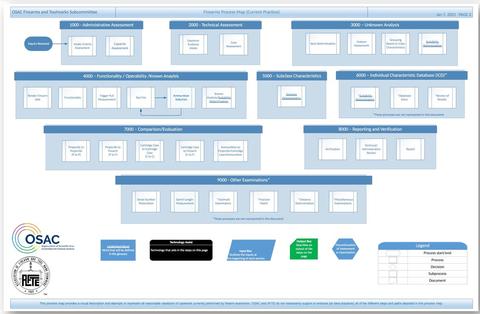
Overview of the Firearms Process Map.
The Organization of Scientific Area Committees (OSAC) for Forensic Science, in partnership with the Association of Firearm and Tool Mark Examiners (AFTE), has developed a process map that describes the process that most firearms examiners use when analyzing evidence.
Firearm examiners are required to make many decisions that can impact the quality and accuracy of their results. The Firearms Process Map, which captures the ‘as-is’ state of firearms examination, provides details about the procedures, methods and decision points most frequently encountered in firearms examination. This map can benefit the firearm discipline by providing a behind-the-scenes perspective into the various components and complexities involved in the firearms examination process. It can also be used to identify best practices, reduce errors, assist in training new examiners and highlight areas where further research or standardization would be beneficial.
The National Institute of Standards and Technology (NIST) Forensic Science Research Program facilitated the development of the Firearms Process Map through a collaboration with OSAC’s Firearms & Toolmarks Subcommittee and AFTE. The process mapping team worked together to capture and document the diverse practices of multiple laboratories.
Process maps are a useful tool that can help forensic science disciplines better understand their current practices. Documenting current practice is an important step that lays the groundwork for further improvements. In addition to the Firearms Process Map, OSAC and its collaborators have developed a Friction Ridge Process Map and Speaker Recognition Process Map that describe the current processes in these disciplines.

